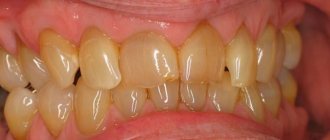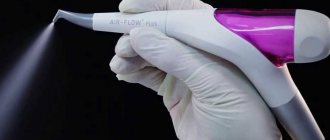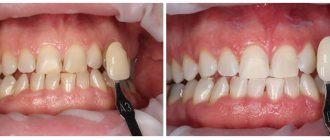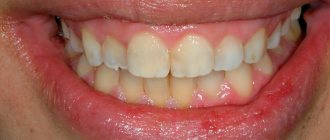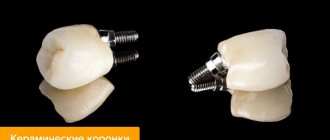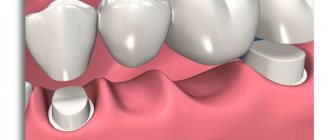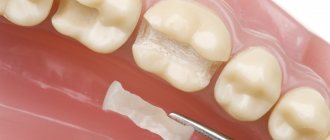When is crown removal necessary?
- Removing the crown from a tooth must be done if the tooth begins to emit an unpleasant odor or hurt. The reason for this may be an inflammatory process that has begun to develop under the prosthesis.
- The second indication for removal and replacement is loosening of the crown. The main reason for this is the resolution of the cement material on which the crown was fixed. This can happen if the dentist chose the material poorly or made a number of mistakes when installing the prosthesis.
- Over time, the crown may need to be replaced. Once every 10 years, you should visit an orthopedist to check how the crown is worn.
- Also, the crown should be replaced if gum inflammation occurs, an injury has occurred, and the patient is awaiting orthodontic treatment.
Why does the prosthesis fall?
Orthopedics is one of the most complex areas of dentistry. For high-quality installation of a prosthesis, in which the likelihood of the crown falling off is minimal, it is necessary to take into account many factors. The size of the lost fragment, individual characteristics of the bite, proper sanitation of the oral cavity before treatment, correct calculation of height - the surgeon must take these and other aspects into account when making prosthetics. A dental bridge is a thin and rather fragile product, especially when made from ceramics. It has increased whiteness and remarkable aesthetic qualities, but, according to statistics, most often it happens that a ceramic crown comes off. The geometry of the turning of the element is of great importance: the more parallel the walls are (the less taper), the lower the likelihood of going to the doctor because the crown has fallen off. Among other reasons for force majeure, the following factors should be noted.
- External influence, for example, sharp pressure when eating solid food. You need to be very careful when biting into apples or chewing nuts with dentures in your mouth.
- Mechanical damage due to injury or impact. This can happen when playing sports or moving awkwardly.
- Low-grade cement that cracks and crumbles over time. You need to use only high-quality mixtures from the world's leading manufacturers.
- Insufficient sanitation of the oral cavity. If saliva or a particle of food remains under the denture, it is possible that the problem of “crown falling off” will soon become urgent.
- Incorrectly calculated biomechanics, in which the prosthesis begins to balance on the base. Proper grinding is an indicator of the dentist’s qualifications.
- Development of caries under orthopedic construction. An infected cavity destroys the enamel, reducing adhesion to the prosthesis.
ON A NOTE! After prosthetics in our clinic there are no such incidents that the crown falls off. Classy specialists, high-tech equipment, and enormous experience eliminate any unpleasant circumstances for clients. But after operations performed in other medical institutions, we often accept patients. Doctors make every effort to re-sharpen the element, if possible, and reliably install the structure. After our work, the question “why the crown fell off” does not arise among visitors.
How to remove crowns from teeth
The dentist performs the procedure using different methods. The choice of method is discussed individually with the visitor and depends on the case. Local anesthesia is required before crown removal. This is done so that the patient does not experience even the slightest discomfort during the procedure.
Coronaflex device
The device removes the crown using compressed air without damaging it. The Coronaflex device can be used to remove a crown without damaging adjacent teeth and soft gum tissue. The crown can be reinstalled after this procedure.
Kopp apparatus
This is a special machine that slowly removes the cement that held the crown in place. Next, the crown is removed using dental forceps.
Ultrasonic scaler
This is a more modern way of removing a crown. However, if the cement is glass ionomer, then this method will not work and you will have to use a Kopp Apparatus.
Sawing
This method is used if the first two before the crown are powerless. The prosthesis is sawn apart and cannot be reused.
If the crown is very loose, it can be removed from the tooth using special forceps.
After the crown is removed from the tooth, the patient needs to receive dental care, which consists of the following:
- File the sharp edges of the tooth, treat with an antiseptic, install a temporary filling;
- Eliminate the inflammatory process, if present.
The exposed root of the teeth is extremely sensitive and needs protection. Therefore, if long-term treatment is planned, the dentist will definitely provide the patient with a temporary prosthesis.
Caring for ceramic crowns and veneers
Ceramic crowns and veneers are orthopedic structures that restore lost tooth tissue or eliminate dental discoloration (discoloration, usually in the anterior section). These structures can be installed in the area of the lateral teeth and are in the form of crowns or inlays, as well as in the area of the front teeth and can be in the form of crowns and veneers (thin overlays that are fixed to the outer surface of the teeth). They are made from various types of ceramics: feldspathic ceramics, glass ceramics, oxide ceramics.
And today there is a misconception that if you have ceramic crowns installed, you can forget about them. Not really! On the contrary, the success of treatment and prosthetics, as well as the service life of restorations, are determined by careful care both at home and in the dental clinic.
Ceramic restorations have an area of contact with tooth tissue in the subgingival region, and in this space between the gum and restoration, as well as on the surface of the crown or veneer itself, plaque can accumulate, which can lead to negative consequences.
Dental plaque is formed in the form of a biofilm - a heterogeneous bacterial mass that is organized as a solid structure (has an extracellular matrix, due to which it is tightly attached to the teeth and to orthopedic structures), which can only be removed mechanically. This biofilm leads to soft tissue inflammation, which disrupts the adherence of the gum to the surface of the restoration and contributes to the formation of subgingival dental plaque, which can disrupt the marginal fit and tightness of the crown/veneer and cause a carious process in the area of the tooth root, lead to gum recession, as well as changes in the color of the restoration, and in advanced cases, its loss.
This is what inflammation of the gums (gingivitis) looks like in the area of ceramic restorations
In this photo you can see soft plaque in the gingival area of the ceramic restoration and inflammation of the gums.
What should you not do after installing veneers?
- It is not recommended to chew nuts, crackers, seeds, etc., and you also need to get rid of the bad habit of gnawing on objects (pens, pencils...), since these products can lead to microcracks with constant exposure, and subsequently to chipped restorations;
- It is not recommended to use highly abrasive pastes on a regular basis, as they can scratch the surface of the ceramic;
- consuming foods that lead to a sharp change in temperature, for example, drinking hot tea after ice cream, this can lead to cracks.
What should you do after installing veneers?
- carry out careful care at home;
- regularly carry out professional dental hygiene procedures;
- regularly visit the dentist for preventive examinations;
- If a crack or chip occurs, consult your doctor immediately;
- follow all recommendations;
- if you engage in extreme sports where there is a risk of injury, it is recommended to use special protective mouth guards;
- If you have bruxism (teeth grinding), it is also necessary to use protective mouth guards.
How to whiten veneers?
This question comes up often. Let's see in what cases veneers can change color?
Ceramics itself does not change color. If the seal of the restoration is compromised, food coloring may be absorbed in this area and the border of the restoration will be stained. In this case, the restoration will most likely need to be replaced. Or, if hygienic care is not observed, plaque becomes fixed on the surface of the restoration, which can become stained and change the color of the veneers. In this situation, professional hygiene, selection of personal hygiene products and training in the correct technique for brushing teeth are necessary.
Professional hygiene of ceramic crowns and veneers
As mentioned earlier, regular professional hygiene is one of the most important criteria for the success of the treatment. This procedure is recommended to be carried out every 3-6 months based on the individual clinical situation and home hygiene skills.
How is professional hygiene of ceramic restorations carried out?
- At the first stage, the hygienist examines and assesses the hygienic status of the oral cavity.
- Then the procedure itself is carried out using gentle techniques (special hand tools, AirFlow using powders based on glycine and erythritol, superflosses, polishing strips, brushes and rubber bands with polishing pastes).
- The next step is to help the doctor select personal hygiene products and adjust home care.
How to properly brush teeth with veneers?
- Teeth should be brushed at least 2 times a day using soft-bristled toothbrushes;
- After each meal, use toothpaste or mouthwash;
- use additional means such as dental floss, superfloss, dental brushes (they will help MECHANICALLY clean hard-to-reach places, which is necessary to remove biofilm - dental plaque);
- use an irrigator.
What toothpastes should I use to care for ceramic crowns and veneers?
As already mentioned, highly abrasive pastes are not recommended for use, and they are not necessary for regular and proper maintenance.
It would be optimal to use pastes with complex action, based on enzymes, pastes with xylitol; they can be alternated with pastes based on herbal ingredients to care for the gums and maintain their health.
Prosthetics with ceramic crowns and veneers is an expensive and quite labor-intensive process. Therefore, it is very important to follow all recommendations and carry out careful hygienic care. This will allow you to avoid complications and enjoy a beautiful and healthy smile for a long time!
Is it possible to cure a tooth without removing the crown?
The integrity of the prosthesis can be preserved in the following cases:
- When the tooth was depulped during installation. First, the doctor will numb the tooth, then drill a small hole in the crown from the chewing surface. It will clean the walls of the canals, seal them and close the hole. This procedure will be carried out in several stages.
- When the tooth was not pulpless when the crown was installed. In this case, the dentist will administer anesthesia and then drill a thin hole in the crown. He will remove the dental nerve, clean the canal and treat the area with an antiseptic. He will fill the canals and place a seal on the drilled hole.
- If the gums around the crown are swollen, then an experienced doctor will clean the oral cavity without removing the denture.
These three cases are somewhat generalized. In each case, the dentist makes a decision on an individual basis. If the tooth under the crown is severely damaged, then even the most experienced professional will not do without first removing the crown in order to provide qualified assistance.
However, the sooner you contact a specialist, the more likely it is that the tooth will be treated without first removing the denture. If the crown was recently placed, it is well made and of high quality, then it makes sense to try to preserve the prosthesis.
In this case, the material of the crown does not matter. You can save metal-ceramics, metal, and zirconium oxide.
Remember that only timely medical care guarantees the preservation of the tooth.
Content:
In modern orthopedic dentistry, a metal-ceramic tooth crown is one of the most popular and versatile types of prosthetics. Inside is a durable metal base made of chrome, cobalt, nickel or gold. Outside – aesthetic ceramics.
In this article we will tell you in detail what are the features, pros and cons of metal-ceramic crowns? What is the cost of metal-ceramic crowns in Krasnodar? How does the installation work? What should be done to extend their service life?
How long will metal-ceramic crowns last?
With proper use and work performed by all specialists at a high level, the service life of metal-ceramic crowns is more than 15 years. After installing a metal-ceramic crown, regular visits to the doctor for preventive examinations are recommended. It is also important to replace the crown in a timely manner to prevent it from chipping or falling out.
